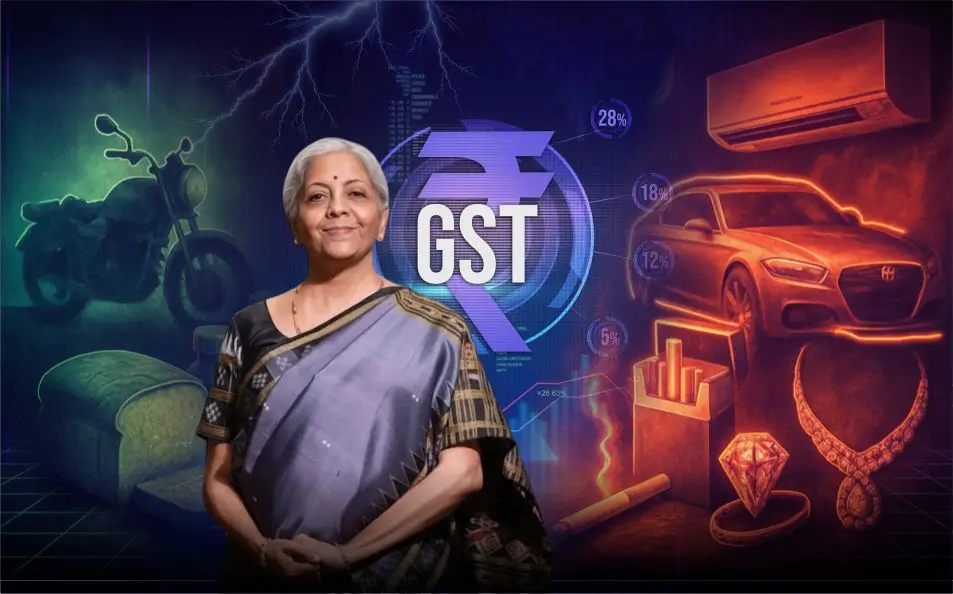CA
Sun, Dec 14, 2025 | 10:12 AM IST
| Delhi | 18°C

The United Indian



When India first introduced the goods and service tax (GST) in 2017, it was called a “game changer.” The idea was bold: one nation, one tax. But the reality was less exciting. With five different slabs, endless clarifications, and confusing bills at checkout counters, GST often felt like a maze instead of a simplification.
This September, the government is pressing the reset button. After a long GST Council Meeting, Finance Minister Nirmala Sitharaman confirmed the arrival of GST 2.0. The new structure trims the clutter, replacing five slabs with two broad categories and a special high-end rate. The changes take effect from September 22, 2025-a date chosen carefully, just before the festive season.
For years, both businesses and households complained that GST was too complicated. Shopkeepers struggled to classify everyday items correctly. A simple question-was a packet of biscuits taxed at 12% or 18%? -caused anxiety. Consumers often wondered why personal care items attracted higher taxes than certain food products.
States weren’t happy either. Revenue sharing turned into a frequent tug of war. With inflation putting pressure on family budgets, the voices for reform grew louder. GST 2.0 is the government’s response: simplify the system, reduce disputes, and make daily life a little easier.
The new framework is deliberately lean. Think of it as three buckets instead of five.
The new GST Rate List is long and detailed, but the essence is clear: essentials affordable, luxuries expensive.
The impact won’t come as a single dramatic saving-it will show up as quiet relief in everyday shopping.
For families already stretched by inflation, these reductions mean a lighter bill at supermarkets and stationery stores.
The government hasn’t gone soft on products it considers harmful or indulgent. Tobacco and related goods now attract some of the highest taxes. The same goes for imported spirits and high-end vehicles. In short, the relief is targeted at middle-class consumption, not luxury lifestyles.
For shopkeepers, GST 2.0 means simpler billing. Fewer slabs mean fewer mistakes and less stress over compliance.
Large Companies
Corporates are already adjusting their strategies. Automakers expect demand to pick up in the mid-range segment. Consumer goods companies anticipate higher volumes as everyday items become more affordable. Electronics and appliance makers are preparing marketing campaigns to take advantage of lower tax burdens.
Economists predict the reform could boost GDP by 0.5-0.8%. Lower inflation from cheaper essentials combined with stronger demand for consumer goods creates a ripple effect: more sales, more production, and eventually, more jobs.
The GST Council Meeting that cleared GST 2.0 wasn’t smooth sailing. It ran for hours, with heated debates between the Centre and states. Yet consensus was achieved. That matters-not just for tax policy, but for showing that cooperative federalism is still possible.
For the government, the timing is strategic. Rolling out reforms ahead of Navratri and Diwali ensures the benefits are felt directly by households. In her statement, Nirmala Sitharaman described GST 2.0 as a “people-first reform” designed to reduce confusion and increase trust.
Revenue Risks: Lower taxes on essentials mean less money in state coffers, at least in the short run. The Centre has promised compensation, but how long it will last is uncertain.
Implementation Pressure: Businesses have little time to adjust software, update invoices, and re-price goods. Any delay could cause chaos.
Passing on Benefits: The key question is whether companies will reduce prices for consumers, or quietly keep profits higher.
Critics warn that without careful monitoring, the reform may look better on paper than in practice.
Most experts agree this is not the final stage of GST reform. Big-ticket items like petroleum, electricity, and real estate are still outside the system. Bringing them under GST remains a challenge for future councils.
There’s also growing interest in using technology-AI tools for compliance, blockchain for invoices, real-time credit checks. If adopted, these could make GST more transparent and less vulnerable to evasion.
It’s easy to get lost in percentages and policy language. But GST 2.0 will be felt in very practical ways.
At the same time, smokers and luxury buyers will carry a heavier tax load. That balance-relief for many, costlier indulgence for a few-is the philosophy behind GST 2.0.
GST 2.0 is India’s second attempt to deliver on the original promise of simplicity. By cutting down to two slabs and keeping luxury goods under a high tax rate, the government has created a structure that is easier to follow, easier to enforce, and friendlier to households.
The real test comes on September 22. If businesses adapt smoothly and consumers feel the difference in their pockets, the GST Council Meeting that approved GST 2.0 will be remembered as a turning point in India’s economic journey.
If implemented smoothly, GST 2.0 will not just be another tax reform but a turning point in India’s economic journey. For The United India, it is a reminder that true progress lies in simplicity, fairness, and a system that works for every citizen.
1. What was decided in the latest gst council meeting?
The gst council meeting finalized the rollout of GST 2.0, which introduces a simpler two-slab system. Starting September 22, 2025, essentials will be taxed at 5%, most goods and services at 18%, while luxury and sin goods will fall under a higher 40% rate.
2. When will the new GST rates come into effect?
The new rates will officially come into effect on September 22, 2025, just ahead of the festive season. Businesses are expected to update their systems quickly to reflect these changes.
3. What does the new gst rate list include?
The new gst rate list places daily-use essentials such as common household products and educational supplies in the 5% bracket. Larger purchases like cars, appliances, and furniture will be taxed at 18%, while luxury items such as tobacco, imported liquor, and luxury vehicles will fall into the 40% slab.
4. How will GST 2.0 affect the common man?
For households, GST 2.0 brings relief on everyday shopping and school supplies, reducing monthly expenses. At the same time, luxury buyers and smokers will face higher costs, as the government aims to make essentials affordable while taxing indulgences more heavily.
5. Why is GST 2.0 being called a turning point?
Unlike the older multi-slab system, GST 2.0 simplifies taxation into broader categories, making compliance easier for businesses and reducing confusion for consumers. Policymakers hope this balance of fairness and simplicity will support growth while building trust in the tax system.